Is PLC learning really difficult? Some people say it's easy to learn, while others find it challenging. In my opinion, it's easy to get started but hard to master. The initial stage is manageable because there are straightforward ways to begin. Many people buy PLC books, but if you look at them from the beginning, about 80% might not be able to learn effectively. This is because abstract concepts and complex theories can overwhelm the mind, making it hard to grasp the basics.
To truly learn PLC, you need a programmable controller and a simple programmer. Without these, it’s almost impossible to practice and verify your understanding. My approach is to jump right into the subject. Here's how I learned:
1. Understand the difference between ladder diagrams and relay control schematics: In relay control, symbols like normally open (NO), normally closed (NC), and coils are used with labels like KM, KA, KT, etc., to identify different devices. However, the number of contacts is limited. In contrast, PLC ladder diagrams use X, Y, M, S, T, C to label soft components. The main advantage is that the same contact can be reused in different steps, which isn't possible with relays. Coils are also similar, with each coil appearing only once per rung.
2. Learn the classification of programming components: Programming components include input relays (X), output relays (Y), auxiliary relays (M), status relays (S), timers (T), counters (C), data registers (D), and pointers (P, I, N). Each has its own function, and understanding their roles is essential for effective programming.
The instruction format is usually LD (function) followed by the component address, such as LD X000 or LDI Y000.
3. Get familiar with basic PLC instructions: (1) LD (Load), LDI (Load Inverse), and OUT (Output) commands: These are the most commonly used. LD represents a normally open contact, while LDI represents a normally closed contact. They are typically used as the first contact in each rung of the ladder diagram.

For example, in the diagram above, the left bus is vertical, and the right bus is not. There are three steps: the first step starts with a normally open contact (X000), the second with a normally closed contact (T0), and the third with another normally closed contact (M0). The correct instruction would be LD X000, LDI T0, and LDI M0. The OUT command is used to drive coils and cannot appear at the start of a rung. It can be connected in parallel but not in series.
(2) AND (And) and ANI (And Inverse): These are used for series connections. Normally open contacts use AND, while normally closed contacts use ANI. Both can be repeated in a single rung.
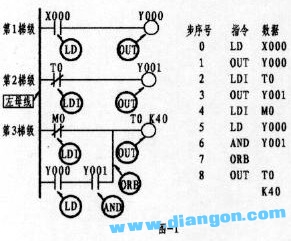
(3) OR (Or) and ORI (Or Inverse): Used for parallel connections. Normally open contacts use OR, and normally closed contacts use ORI. These can be used on any branch within a rung.
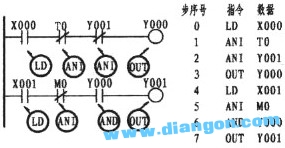
(4) ORB (Or Block): Used when multiple branches are connected in parallel. This is necessary when more than two contacts are in a block.
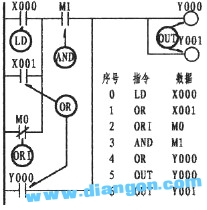
(5) ANB (And Block): Used to connect parallel circuit blocks in series. This is useful when combining two or more circuit blocks.
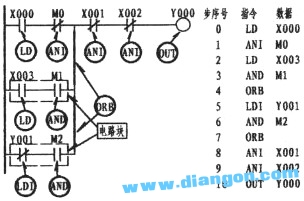
(6) MPS, MRD, MPP, and END: These are stack instructions used for branching. MPS pushes a value onto the stack, MRD reads it, and MPP pops it off. END marks the end of the program.
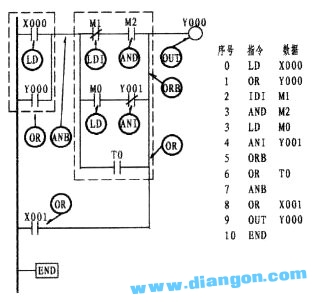
While there are many other instructions, mastering the above should help you get started. Once you understand these, learning more advanced instructions becomes easier. After that, you can move on to more complex projects.
4. Familiarize yourself with the functions of the simple programmer's keys: For example, the FX-10P handheld programmer has various keys, including RD/WR (Read/Write), INS/DEL (Insert/Delete), MNT/TEST (Monitor/Test), CLEAR (Clear), HELP (Help), STEP (Step), SP (Space), cursor keys, and GO (Execute). Each key has specific functions that help in programming and debugging.
5. Learn how to operate the programmer: Connect the PLC to the programmer, power it on, and set the switch to STOP. Then, follow the steps to input commands, delete, insert, and monitor the program. Understanding these operations is crucial for practical application.
6. Input a simple runnable program and run it in monitoring mode: Use the MNT/TEST button to enter monitoring mode and check the program's operation. This helps in identifying issues and improving your understanding of how the PLC works.
7. Try drawing a simple ladder diagram: Start by analyzing an existing electrical schematic and translating it into a PLC ladder diagram. Understand the working principle and avoid simply mapping contacts directly. This helps in developing a deeper understanding of PLC logic.
Examples of common PLC applications include irreversible start, jog control, contactor interlocking, and energy consumption braking. Each requires careful planning and understanding of the logic involved. By practicing with real-world examples, you can enhance your skills and confidence in PLC programming.
Overall, learning PLC is a journey that requires patience, practice, and a solid understanding of the fundamentals. With consistent effort, you'll find it increasingly easier to tackle more complex projects and become proficient in PLC programming.
Battery Energy Storage System (BESS) is a complex system that integrates multiple technologies and devices to store electrical energy in the form of chemical energy and release it for use when needed. The following is a detailed description of the purpose of the BESS class:
I. Basic definition
BESS is a system that uses lithium batteries, lead batteries, etc., as energy storage carriers to store electricity for a certain period of time and supply electricity when needed. The power provided by the system has functions such as smooth transition, peak cutting and valley filling, frequency regulating and voltage regulating, etc. It is of great significance to improve the stability, reliability and flexibility of the power grid.
Second, system composition
BESS mainly consists of the following parts:
Battery Array:
It is the core part of BESS and is used to store electrical energy. Common energy storage batteries include lithium-ion batteries, lead-acid batteries and so on.
The performance of the battery directly affects the efficiency and reliability of the entire energy storage system.
Battery Management System (BMS) :
Responsible for intelligent management and maintenance of each battery unit, prevent the battery from overcharging and overdischarging, and extend the service life of the battery.
Monitor the battery status, including voltage, current, temperature and other parameters, to ensure the safe operation of the battery pack.
Energy Storage converters (PCS) :
It is one of the key devices in BESS, responsible for converting direct current in the battery pack to alternating current, or alternating current to direct current, to meet the needs of different application scenarios.
PCS has the ability to control the flow of electric energy bidirectional, and can flexibly adjust the power and voltage of the grid.
Local controller:
Responsible for local control and management of BESS, including data collection, condition monitoring, fault diagnosis and other functions.
The local controller can also communicate with the external energy management system (EMS) to receive instructions and perform energy scheduling and power control.
Power distribution system:
Devices such as switches, circuit breakers, cables, etc. are included to connect BESS to the power grid or other loads.
Distribution systems need to ensure the safe transmission and distribution of electrical energy.
Auxiliary equipment:
Including temperature control system, fire protection system, lighting system, monitoring system and so on.
These devices are used to ensure the safe operation and routine maintenance of BESS.
3. Technical characteristics
High efficiency:
BESS has high energy conversion efficiency and charge and discharge efficiency, which can maximize the use of stored electrical energy.
Flexibility:
BESS can be flexibly configured and expanded according to actual requirements to adapt to different scales and scenarios.
Reliability:
With advanced BMS and PCS technology, BESS is able to ensure the safe operation and efficient utilization of battery packs and improve the reliability of the system.
Environmental protection:
BESS uses renewable energy for energy storage and power supply, reducing dependence on traditional energy sources and environmental pollution.
BESS Lifepo4 battery, solar power energy system, 3.2V lithium battery cell
Foshan Keylewatt Technology Co., LTD , https://www.klwenergy.com